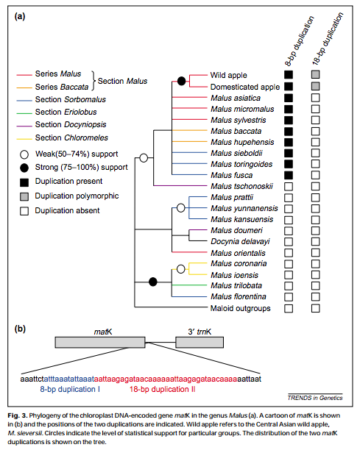It was 1993 and US Department of Agriculture (USDA) horticulturist Phil Forsline flew over the magnificent mountain ranges of south-eastern Kazakhstan in a helicopter. Forsline had not been to the huge Central Asian country before; with the recent fall of the Soviet Union, this was his first chance to visit its wild forests. It was here, scientists now believe, that the ancestors of the apples sold in supermarkets around the globe originally evolved. Forsline was on a quest to find out what was really out there, in those mountain gardens.
The appearance on the BBC website of a long piece on the remarkable apple diversity of Kazakhstan and USDA’s efforts to conserve it, which leads with that mouth-watering paragraph above, reminded me that there was a much weirder little article a few weeks ago on much the same subject that I also wanted to point to. If only for the rhetorical flourishes it unleashes:
There are currently 7,500 varieties of apples in the world today — incredibly though, basically every single one of these can be traced back to a Mother and Father tree in a mysterious Kazakhstan forest.
…
In these Kazakh forests, bears, being the picky buggers that they are, would only pick and eat the sweetest apples.Then they’d go and wander around poop everywhere and the seeds of these sweet, delicious apples were spread around.
Then humans cottoned on and were all “hey, sick apples, bears – we’re gonna eat and grow these to stuff in our mouths as well.”
Then we started only growing these apples which is why out of the thousands of apple varieties that originated from these forests, only 15 of them end up in our grocery stores.
So now, thanks to a group of scientists’ gene sequencing magic, we know that 90% of all apples can be traced back to a Mama and Papa tree thousands of years ago – that was most likely eaten by a bear and then pooped out all over the place.
Very cool.
Incidentally, those bear-filled apple forests have recently been formally recognized with the International Carlo Scarpa Prize for Gardens. And of course they’re not new to the attentions of the popular scientific press. And the not so popular, all due respect to Steppe magazine.
But what you really want to know is where that assertion that all apple varieties can be traced to two trees comes from. Well, so did I, and I asked around, including the apple people at USDA. Nearest I can figure it, it may be based on the fact that an oldish paper looking at the taxonomy of apples found a wild accession in the USDA collection that shared a bit of chloroplast genome with many domesticated varieties. According to the abstract:
Two matK duplications were found, one in series Malus and the other in most M. domestica cultivars and one Central Asian M. sieversii accession.
Here’s what that looks like, from a different paper by the same authors with fancier graphics.

It’s all true about the bears though.
Over millions of years, millions of bears just prior to hibernation slowly and unconsciously selected the larger and sweeter fruits of the neo-apples. Bears do have a sweet tooth, as A. A. Milne noted in Winnie the Pooh. The relative inefficiency of a bear’s jaw in crushing fruit has another unintended consequence. As we have seen above, seeds that remain within the tissue (placenta) of the apple do not germinate. Herb Aldwinckle of Cornell University told me he has noticed that very small apples pass intact and uncrushed through a bear’s jaws and gut and, in one or two cases, were seen intact in the fecal mass. The seeds in the small intact fruits would not have germinated. It does not pay, in a genetic sense, to be a very small apple in the Tian Shan.
LATER: Oh, man, I forgot to link to Jeremy’s podcast.